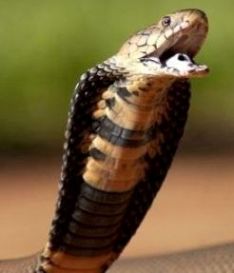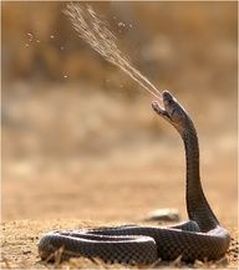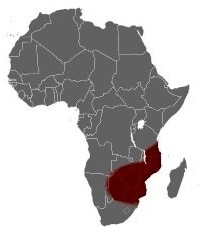Mozambique Spitting CobraNaja mossambica |

Custom Search
|
|
The Mozambique Spitting Cobra (Naja mossambica) is very a common snake in Africa with a very potent venom, the species accounts for many snake bites and for that reason it's considered one of the most dangerous snakes in Africa.
The species is widely distributed in the eastern parts of Southern Africa, most of Mozambique, Swaziland, Zimbabwe, southern Angola, Zambia, Malawi, northeastern Namibia, Northern Botswana and southern Tanzania including on Pemba island. First described in 1854 by Wilhelm Peters, a German naturalist (see taxonomy below). They are found mostly in lowland forest and moist savannas, where it prefers broken, rocky country, hollow logs, termite mounds and animal holes. They are often found close to water sources, unlike the Egyptian Cobra, to which it will readily retreat if disturbed. They are most active at night but may bask near a retreat or forage on overcast days, juvenile specimens are more active during the day. It's also called M'fezi in Shangaan language, which is spoken in the northeast regions of South Africa. Their dorsal side color ranges from slate gray to olive brown with a dark edge in each scale. In the ventral region, they are yellowish or salmon pink, with some black crossbars and blotches on the throat, sometimes forming a band across the ventral scales. They are a relatively small sized and slender snake species, with an adult Mozambique spitting cobra averaging a length of around 1 to 1,2 meters and they rarely exceed 1,5 meters.
The Mozambique spitting cobra species is preyed upon mainly by other snakes. They live for an average of 20 years in captivity. These snakes seldom stand their ground, if cornered it may spread its hood, however, its main defense, other than retreating into hiding, is like their common name implies to spit its venom, just like the rinkhals. However "spraying" venom is probably more accurate. They may also simulate death to avoid further molestation. They do not always spread their hood and may only open the mouth slightly before spitting venom. They can effectively spit from concealed positions. Their fangs are specially modified for spitting the venom, with channel openings in the tips of the teeth directed forward at right angles to the fangs. This allows the Mozambique Spitting Cobra to spit its venom to a distance of 2 or 3 meters and their venom supply is plentiful. If the hair, face or arms are hit by the "spit" the venom poses no threat, but in the eyes, it causes an immediate stinging sensation and blindness and should be washed out immediately with large quantities of water or milk. Subspecies / Taxonomy
There are no subspecies currently recognized for the Mozambique Spitting Cobra. In the past, the Red spitting cobra was considered to be a subspecies of the Mozambique Spitting Cobra but is now considered as a separate species. The species was described in 1854 by Wilhelm Peters, a German naturalist, and explorer. It is considered a "true" cobra since it belongs to the genus Naja, unlike the king cobra (Ophiophagus hannah) despite its common name. Their specific epithet "mossambica" is Latin meaning "Mozambique", referring to where the species is found. Venom / Bite The Mozambique Spitting Cobra does bite depending on the situation it is in. The toxicity of their venom is similar to that of the north American Mojave rattlesnake. The venom yield ranges 80 to 200 mg per bite with the average being around 140 mg, while the lethal dose for an adult human is about 50 mg. In some cases, victims may be bitten multiple times. Like that of most other elapids their venom type is predominantly cytotoxic, and it causes serious local tissue damage.It causes also slight neurotoxic effects, such as drowsiness or reduced breathing. A bite that doesn't receive early treatment, will result in major tissue damage and prolonged hospital stay, to repair the damage by skin grafts. But with early administration of anti-venom, the extent of tissue damage may be reduced and fatalities are rare. Diet / Feeding
They feed mainly on small mammals, birds, lizards, toads, insects and other snakes including the Puff Adder (see video above). They are occasionally found searching for food inside and in the vicinity of houses. Reproduction The Mozambique Spitting Cobra is an oviparous snake species, it lays eggs. The mating season occurs in April and after a gestation period of 2 months, 10 to 22 eggs are laid in mid-summer. The hatchlings measure 23 to 25 cm and are completely independent at birth. Conservation / Threats The Mozambique spitting cobra is abundant and widespread throughout its range, according to the IUCN, although no population estimate is provided. The species is classified as Least Concern (LC) on the IUCN Red List.
|
Scientific classification |
© 2014 Snake Facts About Us | Privacy Policy | Contact







